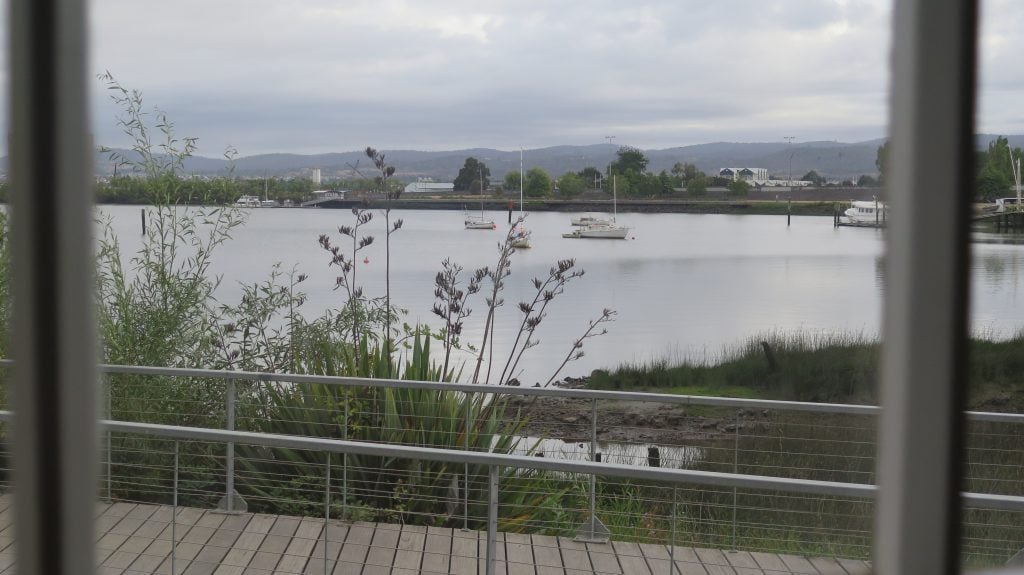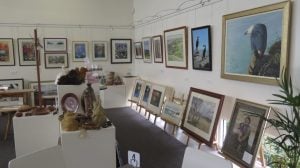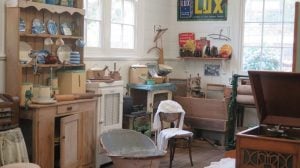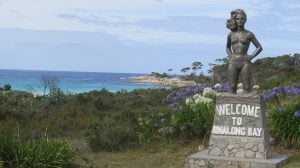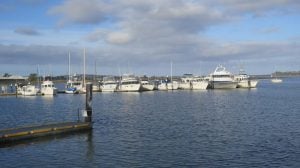17 February 2014
A beautiful view across the Tamar River from Stillwater Restaurant for our last day in Launceston
The restaurant “Stillwater”, housed in a old mill alongside the Tamar River was recommended to us, as we were not able to make it for dinner, we decided to have breakfast there before we left the beautiful harbourside city of Launceston to travel to the east coast. My muesli was first class, and the view across the still Tamar was a delightful way to start the day.
It was effortless to find our way out of Launceston (we are getting to know our way around without the unreliable GPS), and head firstly to Pipers River (only a general store there). A beautiful drive through farms, fields and temperate forests, with the scenery and environment changing all the time.
Comparing our trip yesterday where there were flat farmlands framed with the magnificent mountains, today the fields were undulating like large soft pillows, anchored down with clumps of trees, or a dam – but always the ever-present statuesque mountains in the background.
I noticed initially the farm scenes had a black and white theme – black and white cows, ducks and goats, later sheep and cattle. I love the colour of the few unusual velveteen cows we have seen on our travels.
The beachside holiday town of Bridport was the first stop, very interesting town with lovely beaches, each named after families who had purchased land along the beach front after World War II, hence Goftons Beach (left) and South Eastman beach. It has a working harbour within Anderson Bay, with fishing trawlers and a dry dock, barges that carry freight between the mainland and the Furneaux group of islands including Flinders Island, Cape Barren Island and Clarke Island. Springfield hatcheries have aquaculture pens on the harbour to breed hatchlings.
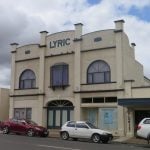 Our next stop, Scottsdale, is quite a large centre with a rich agricultural and forestry history. We had lunch at the cafe in the Art Gallery (right) that had an impressive display of exhibits. We walked along the main street and old The Lyric Theatre made a good photo shot (left).
Our next stop, Scottsdale, is quite a large centre with a rich agricultural and forestry history. We had lunch at the cafe in the Art Gallery (right) that had an impressive display of exhibits. We walked along the main street and old The Lyric Theatre made a good photo shot (left).
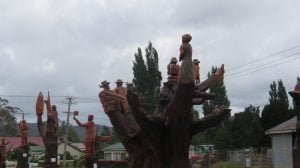 Off the main road is Legerwood, a tiny town that we were interested in visiting because of the work of chainsaw sculptor Eddie Freeman. A row of trees had been planted in Legerwood in October 1918 to commemorate 7 soldiers from the area who lost their lives in WWI. When the trees became unsafe Eddie Freeman was commissioned in 2003 to carve figures from the base of the trees and these were competed by Anzac Day 2006. There is a tree to commemorate each of the soldiers who had died for their country, a tree commemorating Anzac Day and one commemorating Gallipoli.
Off the main road is Legerwood, a tiny town that we were interested in visiting because of the work of chainsaw sculptor Eddie Freeman. A row of trees had been planted in Legerwood in October 1918 to commemorate 7 soldiers from the area who lost their lives in WWI. When the trees became unsafe Eddie Freeman was commissioned in 2003 to carve figures from the base of the trees and these were competed by Anzac Day 2006. There is a tree to commemorate each of the soldiers who had died for their country, a tree commemorating Anzac Day and one commemorating Gallipoli.
Back to the main road and on to Derby, where we stopped at the old School Museum on the way in to town. Derby’s population had swollen to 1500 in the late 1800s when tin was discovered there, and a large Chinese population arrived. In the boom years of 1888 the National Bank of Tasmania was constructed, together with St Paul’s Anglican church, and these are still standing.
A violent storm in 1929 caused the Cascade Dam to burst and the Cascade River to flood and destroy the town, many people lost their lives. All the bridges in the town and surrounds were destroyed. The town and the tin industry never really recovered. The school closed in 1975 when student numbers were reduced to 6, and the school is now a museum with a comprehensive history of the town, and containing a recreation of a typical home of the late 1800s, and a school room, and an interesting window has photographs of many of the school students.
Stepping back in time at the Derby School Museum
Shortly after we arrived at our destination in St Helens on beautiful George’s Bay, and settled into our hotel. We were keen to see the area north of the town called the Bay of Fires, so we set off in that direction. Binalong Bay and The Gardens are quite beautiful, but different, towns on the Bay of Fires. Binalong Bay has glistening white sands with a clean-flowing lagoon, the water is a gorgeous aqua shade. There were people enjoying walking along the sand on the edge of the surf, others were sunning themselves or swimming in the lagoon – quite an idyllic setting.
A perfect day welcomes us to Binalong Bay
We then drove to The Gardens further into the Bay where the shore is very rocky, and interesting red patterns have been formed on the rocks with the orange lichen. It was a beautiful view looking back along George’s Bay and watching the fishermen collecting their crayfish pots.
On the way back to the hotel we came across Lease 65 Oyster Farm selling oysters at $14 for a dozen – plus $1 for a lemon – had to have some to take home as an entree before dinner! They were delicious.
The Gardens in the Bay of Fires with rocks decorated with orange lichen
Back to the hotel in time to change for dinner – this time at Blue Shed, a lovely restaurant about 50 metres walk from the hotel, on George’s Bay with glass walls on three sides. We had a table in the front corner with breathtaking views across the bay, it was a delight to watch the evening close in as we ate a delicious meal. I have to let you know the full title of my meal – “Macquarie Harbour Trout cooked rare at 39 degrees, crusted with potato crisps and puffed ocean trout skin, purple bliss potatoes and goats curd, sugar snaps, lemon gel, micro herbs” – it was as delicious as it sounds!
Our restaurant view overlooking George’s Bay at St Helens
Tomorrow we head south to explore another beautiful beachside town – Bicheno.

